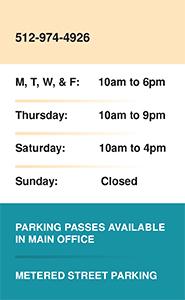
Our Name
Why are we named after George Washington Carver? We honor George Washington Carver through our museum name. Although we are not a museum dedicated to the life and accomplishments of George Washington Carver, we pay tribute to who he was, and honor his contributions to Black culture and history, just as our community did when he became our namesake.
Dr. Carver also had a close relationship with Beverly Sheffield, a devotee to Austin's green spaces and director of Austin's Parks and Recreation Department for 30 years. Carver and Sheffield exchanged fond letters in the 1930s, and two of these letters are on view in the Carver Museum's lobby. Although not an Austinite himself, George Washington Carver has strong historical connections to our community and we are proud to be named after him.
For research inquiries on Dr. Carver, we recommend contacting the following institutions: the George Washington Carver National Monument in Missouri and the Tuskegee Institute National Historic Site in Alabama. Check out more information on George Washington Carver the scientist, the artist, the man.
Our Framework
The George Washington Carver Museum and Cultural Center is housed in a 36,000 square-foot facility that includes four exhibit galleries, a conference room, classroom, darkroom, dance studio, 134-seat theatre, and archival space. The exhibit galleries feature a core exhibit: The African American Presence in 19th Century Texas, a permanent exhibition on Austin African-American families, an Artists’ Gallery, and a Children’s Gallery featuring African-American scientists and inventors.
The George Washington Carver Genealogy Center is nestled beside the museum in an 1,896 square-foot building that originated as Austin’s first library. In 1933, the building was moved to its current location as Austin's first branch library finally allowing use to communities of color, eventually evolving into the frist African American neighborhood museum in Texas. With the opening of the Museum and Cultural Center in 2005, the original building became a genealogy center in 2007. To this day the building serves as a space for Austin's Black community and beyond to research their family history.
Our Mission
Through the preservation and exhibition of African American material culture, history, and aesthetic expression, the Carver Museum works to create a space where the global contributions of all Black people are celebrated.We accomplish this by telling stories about our local community and connecting those histories to larger narratives about Blackness.
Our History
Our history begins in the 1,896 square-foot building that housed Austin’s first library, at the corner of Ninth and Guadalupe Streets. Built in 1926, this small, wood-framed structure was soon overwhelmed by the demands of its patrons. During this time, the citizens of East Austin, along with the American Association of University Women, began to petition the city about the need for a library in their community. As a result, when a larger central library facility was built in 1933, the original building was moved to its current location on Angelina Street and later resurfaced in brick veneer.
In its early years, the Angelina Street library was simply known as the “Colored Branch”. In 1947, however, it was christened the George Washington Carver Branch Library in honor of the inventor and scientist who brought so much pride to African-Americans. For decades, the Carver Library served the Central-East Austin community, and its patronage and book collection grew steadily. Eventually, the need for a larger Carver Branch Library became apparent, and in 1979 a new facility was completed directly adjacent to the original Carver Library.
As for the original building – the community imagined a museum and community center that would promote African-American history and achievement in Austin, Travis County, and beyond. On October 24, 1980, their vision became a reality. What was once Austin’s first library, and what later became Austin’s first branch library, opened its doors as the George Washington Carver Museum and Cultural Center, the first African-American neighborhood museum in Texas.
In a 1998 bond election, the citizens of Austin voted to further expand both the Carver Museum & Cultural Center and the Carver Branch Library. Today, the museum is housed in a 36,000 square-foot facility that includes four galleries, a conference room, classroom, darkroom, dance studio, 134-seat theatre, and archival space. The galleries feature a core exhibit on Juneteenth, a permanent exhibit on Austin African-American families, an Artists’ Gallery, and a children’s exhibit on African-American scientists and inventors.The historic building now houses the genealogy center. The museum, cultural and genealogy center is owned and operated by the City of Austin Parks and Recreation Department, Division of Museums and Cultural Programs.
Our Future
The Carver is a safe space for all that is free and open to the public. We push to preserve, exhibit, display, and support Black history, culture, and art every day. The dream for the George Washington Carver Museum, Cultural and Genealogy Center is to ensure that the space continues serving as the heart of Austin’s Black creative community and beyond. Through the positive growth and meaningful impact of the expansion plan: Phase 2 will provide, the museum building will grow to 90,000 square feet, with indoor additions including new gallery and classroom space along with a 500-seat theater. Our community will have a safe space to tell our stories in our own words, expressions, and narratives. By continuing the work with help and passion from the Austin community, The Carver can continue to be a cultural pillar in east Austin and the Black Cultural District.
Contact Us
| Carre Adams Museum Director & Curator |
J Savannah Museum Site Supervisor 512-974-3660 |
| Deelah Muhyee Event Coordinator 512-974-3680 |
Eric Jarmon Genealogy Center Administrative Specialist 512-974-3666 |
| Cathy Runnels Culture & Arts Education Coordinator (512) 974-3690 |
Christine Pasculado Marketing & Public Programs Supervisor 512-974-3670 |
| Regine Malibiran Exhibit Coordinator 512-974-3654 |
Jennifer Levin Collections Manager 512-974-3661 |
| Vacant Culture & Arts Education Specialist/Theatre & Rentals Lead |
Vacant Culture & Arts Instructor |
| Vacant Culture & Arts Education Coordinator |

